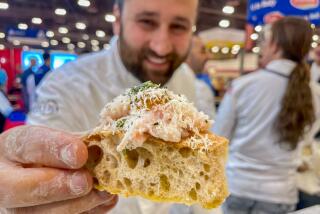The Rich Culinary Tradition of Parmesan Cheese Spans 7 Centuries : ‘Cheese Detective’ Consortium Safeguards Its Ages-Old Reputation
- Share via
BAGANZOLINO, Italy — For its makers, Parmesan cheese is not just something to grate and sprinkle over pasta.
It is rooted in folklore spanning seven centuries and the dairy farmers around Parma in northern Italy who make it do not take kindly to imitations masquerading as the real thing.
For several years their consortium has been policing cheese sellers in Italy, but with the approach of a unified European market in 1992 they are now hoping to extend their tough rules to the rest of the community.
A small squad of consortium “cheese detectives” stakes out shops, street markets and restaurants, mostly in Italy but also in France and Switzerland where the Parmesan name is guaranteed under bilateral agreements.
“The consortium has limited means so we depend mostly on food industry officials and consumers to tell us about infringements. But we also use four to six of our employees to make inspections,” consortium president Giampaolo Mora said.
Under an Italian law passed in the 1950s cheese can carry the Parmesan name only if it is made according to a 700-year-old method in a small area defined by natural boundaries including the Po River.
Unlike Grana, a similar cheese in taste and texture produced north of the Po, Parmesan contains no artificial additives and is made entirely by hand. It also costs up to 25% more.
Definitely Not the Real Thing
Mora, a lawyer and a Christian Democrat senator, said his organization was fighting several small companies in the courts. “There are many retailers selling what they call Parmesan which is definitely not the real thing,” he said.
Mora and representatives of five other EC countries thrashed out the text of an agreement defining the cheese in Paris and he said he was lobbying for its extension to other member nations.
“Italians know Parmesan when they see it, but foreigners are more easily taken in,” he said.
Just outside Parma at the Baganzolino cooperative, one of 930 farms authorized to produce Parmesan, you begin to appreciate the cheese’s near-mystical prestige.
Across the flat Po Valley plains, which in winter are almost permanently shrouded in low mist, cows eat only fresh grass or hay. Other feed lowers the quality of their milk and affects Parmesan’s golden-yellow hue.
Milk is left in metal basins overnight and then skimmed. After being heated in a copper vat for an hour, a solid mass forms which is drawn out with a long-handled metal sieve.
Only Natural Ingredients
While Grana manufacturers use an artificial setting agent at this stage, Parmesan makers just add rennet, a coagulant found in calves’ stomachs.
The 260 gallons of milk in each vat reduce to just two big cheeses, which are pressed out in a circular wooden mold about 18 inches in diameter and left to solidify.
The cheese is then immersed for a month in salt solution and stencilled with the Parmesan stamp and a code number to identify the farm which made it.
At Baganzolino cheeses are stored on stacks 21 shelves high like books in a library. During the two years it takes them to mature they are regularly turned and brushed to avoid the build-up of mold.
Traditional Methods
The master cheese maker will use a metal hammer to test each cheese for the right sound and extract samples with a spiral hook for chemical analysis.
“Making Parmesan is a ritual,” Mora said. “The only thing which has changed in 700 years is that the milk is heated by gas instead of wood.”
It is also big business. The consortium has a turnover of $950 million each year, producing two and a half million cheeses. It exports only 6% of its output, but Mora said the European market was expanding fast.
Whether because of the geographical location or the devoted precision with which the farmers make the cheese, it seems that Parmesan is indeed impossible to imitate elsewhere.
Mora said a farm in Normandy tried making it with local milk following the traditional method but failed to reproduce the fragrance and rich crumbly texture which make Parmesan as delicious eaten as a dessert cheese as when grated on spaghetti.
“Before being a great cheese it is art, life, an almost sacred symbol of peasant culture,” the consortium’s director, Luigi Verrini, has written.
Transferring that culture abroad defeated even Thomas Jefferson, who wanted to start making the cheese in the newly independent United States 200 years ago.
After he became President in 1801, Jefferson wrote to an Italian friend: “You were right, it’s better to leave Parmesan making to the people who know what they are doing.”
More to Read
Eat your way across L.A.
Get our weekly Tasting Notes newsletter for reviews, news and more.
You may occasionally receive promotional content from the Los Angeles Times.










